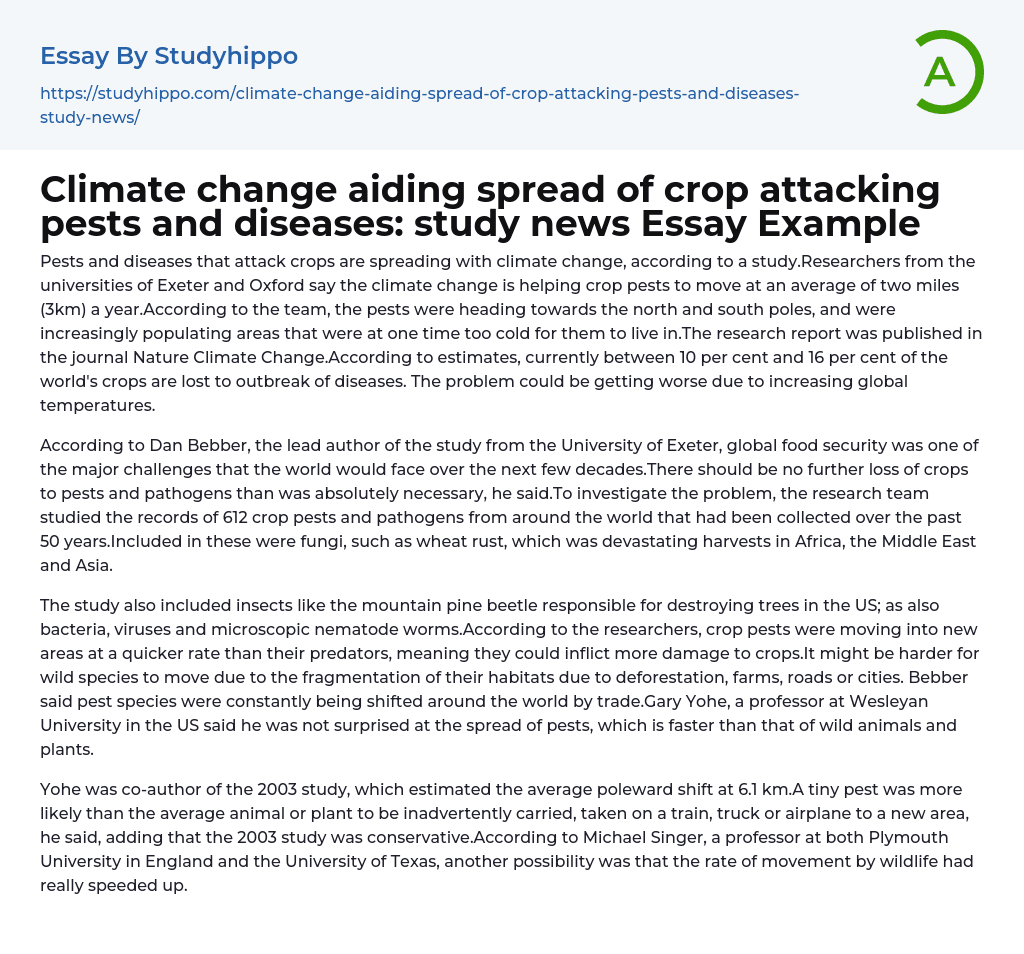

Climate change aiding spread of crop attacking pests and diseases: study news Essay Example
According to research by the universities of Exeter and Oxford published in Nature Climate Change, climate change is causing crop pests and diseases to increase. The study shows that on average, crop pests are moving towards the north and south poles at a rate of about two miles (3km) per year, expanding their reach into previously uninhabitable regions. This has led to a current loss of 10% to 16% of crops worldwide due to disease outbreaks, with the problem expected to worsen as global temperatures continue to rise.
Dan Bebber from the University of Exeter highlights that global food security will be a significant challenge in the future. The reduction of crop damage caused by pests and pathogens is crucial. To tackle this issue, Bebber's team analyzed data on 612 crop pests and diseases across different locations over five decades. This includes fungi like
...wheat rust, which has severely affected crops in Africa, Asia, and the Middle East.
According to the study, a variety of species were examined, including insects like the mountain pine beetle that causes harm to US trees, along with viruses, bacteria, and microscopic nematode worms. The results indicated that crop pests were relocating at a quicker pace than their predators, resulting in an escalation of crop damage. Deforestation, farming activities, roadways and urbanization have led to habitat fragmentation which can impede wild species' movement. Global trade is one way in which pest species are frequently transported across borders. Gary Yohe who teaches at Wesleyan University in the United States observed that pests spread faster compared to wild animals and plants.
Yohe, co-author of the 2003 study, conservatively estimated that the average polewar
shift was 6.1 km. He noted that tiny pests are more likely than other organisms to be unintentionally transported to new areas via trains, trucks, or airplanes. Professor Michael Singer, from both Plymouth University in England and the University of Texas, suggested another possibility: that the movement rate of wildlife had significantly increased.
- Agriculture essays
- Albert einstein essays
- Animals essays
- Archaeology essays
- Bear essays
- Biology essays
- Birds essays
- Butterfly essays
- Cat essays
- Charles Darwin essays
- Chemistry essays
- Dinosaur essays
- Discovery essays
- Dolphin essays
- Elephant essays
- Eli Whitney essays
- Environmental Science essays
- Evolution essays
- Fish essays
- Genetics essays
- Horse essays
- Human Evolution essays
- Isaac Newton essays
- Journal essays
- Linguistics essays
- Lion essays
- Logic essays
- Mars essays
- Methodology essays
- Mineralogy essays
- Monkey essays
- Moon essays
- Mythology essays
- Noam Chomsky essays
- Physics essays
- Plate Tectonics essays
- Progress essays
- Reaction Rate essays
- Roman Numerals essays
- Scientific essays
- Scientific Method essays
- Scientist essays
- Seismology essays
- Space Exploration essays
- Stars essays
- Sun essays
- Thomas Edison essays
- Tiger essays
- Time Travel essays
- Universe essays



